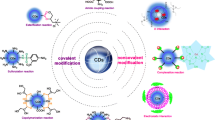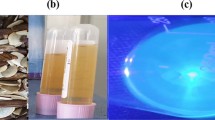Abstract
A composite probe has been developed for fluorometric determination and imaging of phosphate in real water samples and in cells. The method is based on the use of weakly blue fluorescent bromine-doped carbon dots (C-dots) containing aromatic carbon-bromine groups and loaded with Fe3+ ions. The carboxy, phenolic hydroxy and aldehyde groups on the surface of the C-dots can coordinate with Fe3+ to form an adsorbed complex that reduces the blue fluorescence through an inner filter effect. If phosphate is added, it will capture Fe3+ on the surface of C-dots and restore fluorescence by ~88% via a displacement approach. The probe, best operated at excitation/emission maxima of 370/418 nm, has a linear response in the 0.4 to 22 μM phosphate concentration range and a 0.25 μM of detection limit. The relative standard deviation (at a phosphate level of 8.0 μM) is 3.6% (for n = 5). The method was applied to confocal imaging of phosphate in HeLa cells.

Schematic representation of the synthesis of bromine-doped carbon dots (C-dots) by a “one-step” approach. They are shown to be capable of (a) detecting phosphate in real water samples through the displacement approach, and (b) of imaging intracellular phosphate.







Similar content being viewed by others
References
Patey MD, Rijkenberg MJA, Statham PJ, Stinchcombe MC, Achterberg EP, Mowlem M (2008) Determination of nitrate and phosphate in seawater at nanomolar concentrations. Trends Anal Chem 27:169–182
USEPA (2000) Nutrient criteria technical guidance manual, Office of Science and technology. U.S. EPA, Washington, DC
Ahmad R, Ahn M-S, Hahn Y-B (2017) ZnO nanorods array based field-effect transistor biosensor for phosphate detection. J Colloid Interface Sci 498:292–297
Kopieca G, Starzecb K, Kochanab J, Kinnunen-Skidmorec TP, Schuhmannd W, Campbellc WH, Ruffd A, Plumeré N (2018) Bioelectrocatalytic and electrochemical cascade for phosphate sensing with up to 6 electrons per analyte molecule. Biosens Bioelectron 117:501–507
Chowdhury B, Sinha S, Ghosh P (2016) Selective sensing of phosphates by a new bis-heteroleptic RuII complex through halogen bonding: a superior sensor over its hydrogen-bonding analogue. Chem Eur J 22:18051–18059
Borse V, Jain P, Sadawana M, Srivastava R (2016) ‘Turn-on’ fluorescence assay for inorganic phosphate sensing. Sensors Actuators B Chem 225:340–347
Zhao J, Yang D, Zhao Y, Yang X-J, Wang Y-Y, Wu B (2014) Anion-coordination-induced turn-on fluorescence of an oligourea-functionalized tetraphenylethene in a wide concentration range. Angew Chem Int Ed 53:6632–6636
Cao H, Chen Z, Huang Y (2015) Copper nanocluster coupling europium as an off-to-on fluorescence probe for the determination of phosphate ion in water samples. Talanta 143:450–456
Dai C, Yang C-X, Yan X-P (2015) Ratiometric fluorescent detection of phosphate in aqueous solution based on near infrared fluorescent silver nanoclusters/metal-organic shell composite. Anal Chem 87:11455–11459
Zhang X, Jiang M, Niu N, Chen Z, Li S, Liu S, Li J (2018) Natural-product-derived carbon dots: from natural products to functional materials. ChemSusChem 11:11–24
Zhou Y, Sharma SK, Peng Z, Leblanc RM (2017) Polymers in carbon dots: a review. Polymers 9:1–20
Zou W-S, Ji Y-J, Wang X-F, Zhao Q-C, Zhang J, Shao Q, Liu J, Wang F, Wang Y-Q (2016) Insecticide as a precursor to prepare highly bright carbon dots for patterns printing and bioimaging: a new pathway for making poison profitable. Chem Eng J 294:323–332
Zou W-S, Zhao Q-C, Zhang J, Chen X-M, Wang X-F, Zhao L, Chen S-H, Wang Y-Q (2017) Enhanced photoresponsive polyethyleneimine/citric acid co-carbonized dots for facile and selective sensing and intracellular imaging of cobalt ions at physiologic pH. Anal Chim Acta 970:64–72
Zou W-S, Ye C-H, Wang Y-Q, Li W-H, Huang X-H (2018) A hybrid ratiometric probe for glucose detection based on synchronous responses to fluorescence quenching and resonance light scattering enhancement of boronic acid functionalized carbon dots. Sensors Actuators B Chem 271:54–63
Hutton GAM, Martindale BCM, Reisner E (2017) Carbon dots as photosensitisers for solar-driven catalysis. Chem Soc Rev 46:6111–6123
Gao J, Zhu M, Huang H, Liu Y, Kang Z (2017) Advances, challenges and promises of carbon dots. Inorg Chem Front 4:1963–1986
Zou W-S, Zhao Q-C, Kong W-L, Wang X-F, Chen X-M, Zhang J, Wang Y-Q (2018) Multi-level fluorescent logic gate based on polyamine coated carbon dots capable of responding to four stimuli. Chem Eng J 337:471–479
Zhang YQ, Ma DK, Zhuang Y, Zhang X, Chen W, Hong LL, Yan QX, Yu K, Huang SM (2012) One-pot synthesis of N-doped carbon dots with tunable luminescence properties. J Mater Chem 22:16714–16718
Papirer E, Lacroix R, Donnet JB, Nanse G, Froux P (1994) XPS study of the halogenation of carbon black-part 1. Bromonation. Carbon 32:1341–1358
Zhang Z, Shi Y, Pan Y, Cheng X, Zhang L, Chen J, Li MJ, Yi C (2014) Quinoline derivative-functionalized carbon dots as a fluorescent nanosensor for sensing and intracellular imaging of Zn2+. J Mater Chem B 2:5020–5027
Sahu S, Behera B, Maiti TK, Mohapatra S (2012) Simple one-step synthesis of highly luminescent carbon dots from orange juice: application as excellent bioimaging agents. Chem Commun 48:8835–8837
Zheng H, Wang Q, Long Y, Zhang H, Huang X, Zhu R (2011) Enhancing the luminescence of carbon dots with a reduction pathway. Chem Commun 47:10650–10652
Wang L, Wang Y, Xu T, Liao H, Yao C, Liu Y, Li Z, Chen Z, Pan D, Sun L, Wu M (2014) Gram-scale synthesis of single-crystalline grapheme quantum dots with superior optical properties. Nat Commun 5:5357
Zhu S, Zhang JH, Tang SJ, Qiao CY, Wang L, Wang HY, Liu X, Li B, Li Y, Yu W (2012) Surface chemistry routes to modulate the photoluminescence of grapheme quantum dots: from fluorescence mechanism to up-conversion bioimaging applications. Adv Funct Mater 22:4732–4740
Paredes JM, Giron MD, Ruedas-Rama MJ, Orte A, Crovetto L, Talavera EM, Salto R, Alvarez-Pez JM (2013) Real-time phosphate sensing in living cells using fluorescence lifetime imaging microscopy (FLIM). J Phys Chem B 117:8143–8149
Zu F, Yan F, Bai Z, Xu J, Wang Y, Huang Y, Zhou X (2017) The quenching of the fluorescence of carbon dots: a review on mechanisms and applications. Microchim Acta 184:1899–1914
Wang B, Hai J, Liu Z, Wang Q, Yang Z, Sun S (2010) Selective detection of iron(III) by rhodamine-modified Fe3O4 nanoparticles. Angew Chem Int Ed 49:4576–4579
Zhou Y, Zhang H-Y, Zhang Z-Y, Liu Y (2017) Tunable luminescent lanthanide supramolecular assembly based on photoreaction of anthracene. J Am Chem Soc 139:7168–7171
Rong M, Feng Y, Wang Y, Chen X (2017) One-pot solid phase pyrolysis synthesis of nitrogen-doped carbondots for Fe3+ sensing and bioimaging. Sensors Actuators B Chem 245:868–874
Zhang H, Chen Y, Liang M, Xu L, Qi S, Chen H, Chen X (2014) Solid-phase synthesis of highly fluorescent nitrogen-doped carbon dots for sensitive and selective probing ferric ions in living cells. Anal Chem 86:9846–9852
Acknowledgments
This work was supported by Natural Science Research Project of Anhui Province (KJ2018A0513) and the Doctor Foundation (2016QD108) of Anhui Jianzhu University. Also, the authors thank National Natural Science Foundation of China (21506002, 41673131, 21671003, 21876001), and Postdoctor Foundation (2017 M612091) for financial support.
Author information
Authors and Affiliations
Corresponding authors
Ethics declarations
The author(s) declare that they have no competing interests.
Additional information
Publisher’s note
Springer Nature remains neutral with regard to jurisdictional claims in published maps and institutional affiliations.
Electronic supplementary material
ESM 1
(DOCX 519 kb)
Rights and permissions
About this article
Cite this article
Zou, WS., Kong, WL., Zhao, QC. et al. A composite consisting of bromine-doped carbon dots and ferric ions as a fluorescent probe for determination and intracellular imaging of phosphate. Microchim Acta 186, 576 (2019). https://doi.org/10.1007/s00604-019-3700-6
Received:
Accepted:
Published:
DOI: https://doi.org/10.1007/s00604-019-3700-6




